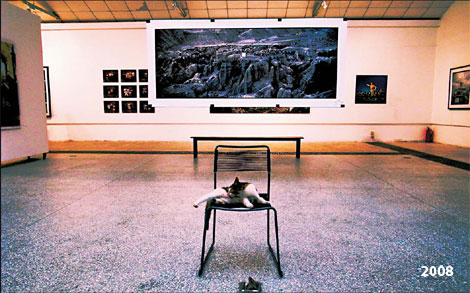|
|
 |
|
30th Anniversary Celebrations
Economic Development
New Rural Reform Efforts
Political System Reform
Changing Lifestyle
In Foreigners' Eyes
Commentary
Enterprise Stories
Newsmakers
Photo Gallery
Video and Audio
Wang Wenlan Gallery
Slideshow
Key Meetings
Key Reform Theories
Development Blueprint
Li Xing:
Teachers like Li need our support Alexis Hooi:
Going green in tough times Hong Liang:
Bold plan best option for economy From guns to easels
By You Nuo (China Daily)
Updated: 2008-07-28 14:23
 
We have two photos taken around the same time at a former secret military factory complex in Beijing. It was built in the era of the planned economy, under the code name 798. One photo shows what Factory Complex 798 was like in its old days. Spacious, bland and generic industrial red-brick workshops was the style A worker can be seen doing renovation work in the photo. The results of his labor are seen in the other photo showing the new 798. With most of its sterile industrial workshops and offices converted into art galleries and creative studios, 798 is a now a favorite hangout for Beijing-based artists, art dealers, art lovers and tourists. There may still be some remnants of the planned economy in the military-industrial style buildings, but the new theme hardly reminds one of its secretive past. Tucked in the rows of revamped houses in 798, surrounding one coffee shop after another, there are small companies and galleries run by young artists - to organize exhibits, to take design contracts, for animation, to sell imported and domestic art books and to publish magazines. On the surface, the metamorphasis of Beijing 798 is an accident of the market economy, in which a bunch of individuals with creative ideas and a will to implement them were luckily joined by tolerant city administrators who did not send someone to write the big white character "chai" (knock down for urban redevelopment) on the old houses and factories. It is every urban center's duty to keep some artistic circles flourishing in a way to also attract more talent from home and abroad. In China, although some pompous officials in cities can boast to visitors of the shiny office buildings they have constructed and the massive (and often empty and wasteful) new investment zones; all claiming to having turned their cities into modern-day financial centers in only a few years, it is virtually only Beijing and Shanghai which have been able to nurture unique, vibrant areas for artists and other creative professionals. But as is vividly shown with Beijing 798, for any city the essential difference between a market economy and a planned economy is not how the buildings look, or how much money they may contain, but instead it is the ideas within.
  
 |